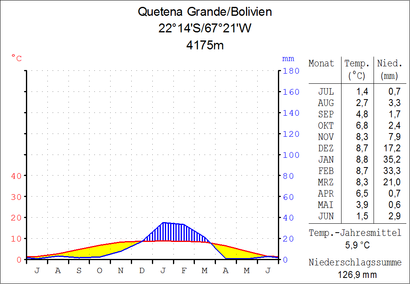Río Quetena
| Río Quetena | ||
|
Peña Barrosa in the valley of the Río Quetena |
||
| Data | ||
| location | Bolivia | |
| River system | Río Grande de Lípez | |
| Drain over | Río Grande de Lípez → Salar de Uyuni | |
| source |
Reserva Nacional de Fauna Andina Eduardo Abaroa 22 ° 25 ′ 28 ″ S , 67 ° 21 ′ 43 ″ W |
|
| Source height | 4554 m | |
| muzzle |
Río Grande de Lípez Coordinates: 21 ° 13 ′ 19 ″ S , 67 ° 8 ′ 57 ″ W 21 ° 13 ′ 19 ″ S , 67 ° 8 ′ 57 ″ W. |
|
| Mouth height | 3736 m | |
| Height difference | 818 m | |
| Bottom slope | 4.5 ‰ | |
| length | 182 km | |
| Left tributaries | Río Mallcu, Río Alota | |
| Right tributaries | Río Soniquero | |
| Navigable | No | |
The Río Quetena is an endorheic river in the Potosí department in the Andean high mountains of southern Bolivia .
The river with a total length of 182 kilometers has its origin in the nature reserve Reserva Nacional de Fauna Andina Eduardo Abaroa in the canton of Quetena Grande in the district ( Bolivian : Municipio ) of San Pablo de Lípez in the province of Sur Lípez . The source region of the river lies at an altitude of 4,554 m in the mountainous region of the Cordillera de Lípez .
The Río Quetena flows from south to north through the municipality of Colcha "K" in the province of Nor Lípez through largely unpopulated area, where the Río Mallcu and the Río Alota flow from the left and the Río Soniquero from the right. After 182 kilometers it flows into the Río Grande de Lípez , which flows further into the Salar de Uyuni (also Salar de Tunupa ), the largest salt lake on earth with more than 10,000 km² .
The region suffers from great drought for much of the year, the annual precipitation is very low with less than 150 mm (see climate diagram Quetena Grande), it has less than 10 mm monthly average from April to November, only falls in the southern summer months of November to March significant rainfall, so that the Río Quetena and its tributaries only carry water periodically. Despite a low annual average temperature of 6 ° C, due to the proximity to the equator there is a high level of solar radiation during the day, so that the average maximum daily temperature during the year is between 10 and 16 ° C; this results in above-average evaporation in the midday hours and the proportion of mineral salts dissolved in the water increases, which explains the high salt content of the rivers and lakes in this region.
In addition, scientific studies over the past few decades show that a significant part of the surface water does not come from the scant rainfall in the region, but is deep water from aquiferous rock layers that have accumulated over the past decades. A study by I. Chaffaut assumes that more than 90 percent of the surface water comes from these deep water reservoirs and is irretrievably lost through the superficial runoff.

